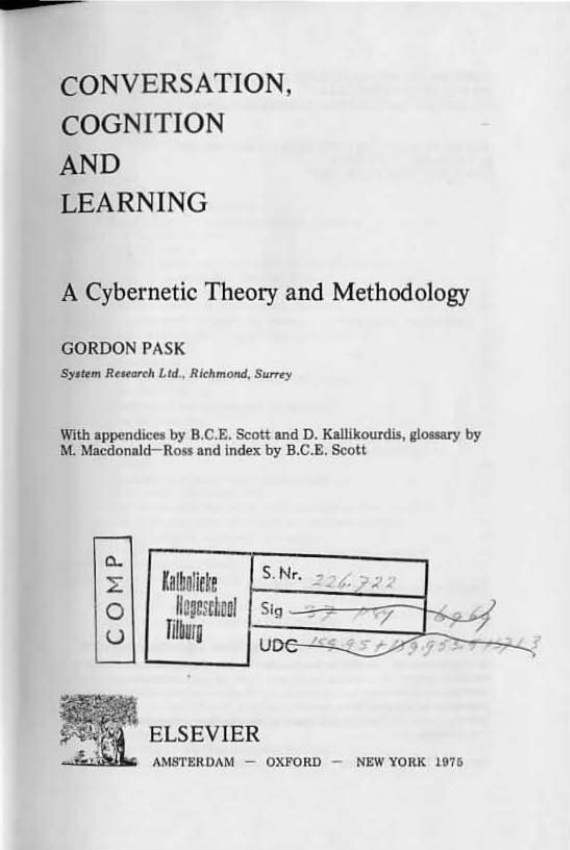Gordon Pask: The Cybernetics of Human Learning and Performance: A Guide to Theory and Research (1975)
Filed under book | Tags: · abstract machine, cybernetics, learning, machine

“This book assumes a background knowledge commensurate with having read its predecessor An Approach to Cybernetics (1961) of which some passages are a direct continuation. All that is needed from a system/cybernetic point of view is available in Ashby’s lucid and still up-to-date Introduction to Cybernetics (1965), though the reader with a bent and liking for mathematics will find Glushkov’s Introduction to Cybernetics (1966) profound and comprehensive (the nearly identical title is due to translation). There is a glossary covering all essential technical terms at the end of the book. Readers may find this helpful, not so much because of obscure symbolism (very little is employed) but because ordinary language phrases are used, from time to time, with rather exact meaning; in order to avoid symbols. This trick is played quite often with logical and mathematical terms; sometimes with the relatively comprehensible jargon of psychology, educational science, and philosophy. The other offending speciality is electronics. Knowledge of the subject is unimportant, since the function of components is explained or illustrated. Some otherwise abstract notions are made tangible by the description of electrical machinery; people who are versed in the field may find the details interesting and amusing (especially in Chapter 5 where methods are quaintly redolent of the late 1950s and early 1960s). But there is no need to labour these points; only the function of the machinery bears directly upon the main theme.” (from Preface)
Publisher Hutchinson Educational, 1975
ISBN 0091194903, 9780091194901
347 pages
via pangaro.com
PDF (28 MB, updated on 2017-10-25)
Comment (0)Gordon Pask: Conversation, Cognition and Learning. A Cybernetic Theory and Methodology (1975)
Filed under book | Tags: · cognition, communication, cybernetics, education, learning, psychology

“The work on which the content of this book is centred took place over more than a decade. It started, in the middle fifties, with the construction of adaptive training machines, with superficially disconnected studies of chemical computing systems, and, towards 1960, with experiments on machine-monitored small group inter-action. Since that period an underlying theory has emerged from a gaggle of prescient concepts. It owes a great deal of its present shape to the ideation and criticism of friends and colleagues, only some of whom can be mentioned directly.
First of all, it is noteworthy that parallel work has gone on in two places; my own laboratory at System Research Ltd and in Heinz Von Foerster’s Biological Computer laboratory, at the University of Illinois. Both endeavours were encouraged by Warren McCulloch; the reader will detect the influence of his ideas and guidance appearing repeatedly throughout the discussion. Apart from this, the parallel development was not specially contrived and it was sustained by irregular personal liason. Hence, it is gratifying to find that recent publications from the Biological Computer Laboratory image our own conclusions, differing, chiefly, in the notation employed and the area of application. People familiar with the field will probably find the threads of mutualism quite obvious; for the benefit of others, a few of these threads are picked out. For example, Loefgren worked with Von Foerster whilst refining the formalism on which the currently-used type of abstract reproductive and evolutionary process is founded; Maturana (whose theory of autopoietic systems is the analogue, in a biologist’s mind, for certain stable cognitive organisations in the present theory) worked there as well; Maturana’s theory is to appear in a subsequent monograph in this series. Both Ashby, the system theorist, and Gunther, the philosopher, taught and researched with Von Foerster; much of the present theory hinges upon their ideas.
On home ground, the theory, and the experiments as well, owe a great deal to two colleagues of long standing: Brian Lewis and Bernard Scott. Prof. Lewis and I shared a common interest in cognition since early in the 1960s and brooded jointly (as we still do) over problems of learning and teaching. Bernard Scott came to the laboratory at the time when Lewis went off to study education in the large and since that time we have maintained a comparably symbiotic intellectual relationship. At about the time I started to write this manuscript (having discarded many previous drafts of it as inadequate) both circumstance and research interest brought all of us into close contact again and we were joined, in the last year, by Dionysious Kallikourdis (who contributes one Appendix, explicitly).” (Gordon Pask, from Preface)
With appendices by B.C.E. Scott and D. Kallikourdis, glossary by M. Macdonald-Ross and index by B.C.E. Scott
Publisher Elsevier, Amsterdam/Oxford/New York, 1975
ISBN 0444411933, 9780444411938
570 pages
via pangaro.com
PDF (updated on 2012-7-16)
Comment (0)Journal of Community Informatics (2004–)
Filed under journal | Tags: · activism, civil society, community, community informatics, digital divide, e-government, gender, ict, information technology, internet, learning, technology, wireless networks

“Community Informatics (CI) is the study and the practice of enabling communities with Information and Communications Technologies (ICTs). CI seeks to work with communities towards the effective use of ICTs to improve their processes, achieve their objectives, overcome the “digital divides” that exist both within and between communities, and empower communities and citizens in the range of areas of ICT application including for health, cultural production, civic management, e-governance among others. CI is concerned with how ICT can be useful to the range of traditionally excluded populations and communities, and how it can support local economic development, social justice and political empowerment using the Internet. CI is a point of convergence concerning the use of ICTs for diverse stakeholders, including community activists, nonprofit groups, policymakers, users/citizens, and the range of academics working across (and integrating) disciplines as diverse as Information Studies, Management, Computer Science, Social Work, Planning and Development Studies. Emerging issues within the CI field include: community access to the internet, community information, online civic participation and community service delivery, community and local economic development, training networks, telework, social cohesion, learning, e-health and e-governance. The Journal of Community Informatics aims to bring together a global range of academics, CI practitioners and national and multi-lateral policy makers policy makers. Each issue of the Journal of Community Informatics contains a number of double blind peer-reviewed research articles as well as commentaries by leading CI practitioners and policy makers providing feedback on how the significance and application of research for practice and policy development.”
Editor in Chief: Michael Gurstein
Associate editors: Shaun Pather, Alvin Wee Yeo
Open access
ISSN 1712-4441

